
A Variety of Oddments
Burnham made pens for a number of other concerns.
Download An Oddy with Tentacles here
Foreigners
We know from previous literature that Burnham made pens for a number of outlets. Terence Coleman in the Dreampens site gives most of them. He mentions Chatsworth for Boots; and pens for Kennards of Croydon, Gamages, and Waverley. Burnham also made pens for CAW’s in the postwar period (maybe pre- WW2 as well but I haven’t seen any). Burnham made Pelham pens for Boots in the post-war period. I haven’t found any pre-war Pelham pens mentioned but Pelham was a name used for a number of Boots’ own-brand stationery products from the pre-war times. In fact I grew up with writing-paper boxes labelled Pelham Bond. Koppykleen pens were definitely Burnham products in the 1950's, made for Thames Manufacturing Co. Ltd. which made Koppykleen carbon paper. Other pens with unusual imprints are known, and Burnham also made specially imprinted pencils for firms as small as garages, or as big as the BBC - they made imprinted pencils for Crackerjack.
Chatsworth for Boots is discussed in detail and illustrated with the related Burnham no. 56 so I’ll just mention it here.
When Burnham made pens for others their design department must sometimes have gone into overdrive. I’ve already given reasoning that suggests the Burnham model 56 was cobbled together from parts of the Chatsworth pen and the Burnham 47/51. The same sort of “design” process seems to have been employed for the Pelham pen and for the Koppykleen one. These two pens make a very curious comparison. They are at first sight extraordinarily alike, marbled casein, 3 unequal cap bands, jewel-clipped pens with either Boots or KOPPYKLEEN on the clip, and the Pelham bears its name imprinted on the barrel. Both have Warranted 14 ct nibs, the Koppykleen are quite ordinary but the Pelham ones are lettered in the cursive script Burnham used for most of their own nibs. An exercise with a ruler shows that the barrels are identical to the similar no. 55 and the caps are identical to the similar no. 60. An easy hybridisation gave rise to both these models..... but wait a minute, look inside the caps. The Pelhams have a screw-fixed jewel and the Koppykleens have a rivetted one. So either the Koppykleens were made earlier than the Pelhams or Koppykleen positively specified a rivetted fixing...... we’ll never really know which, I feel. In spite of the older style riveted clip fixing, the Koppykleens were not very early products as they had ladder feeds rather than plain. The Pelham was quite late-period and probably had only a brief reign at Boots. It is not in the 1955-8 list, is in the 1960-2 list, and not in the 1962-4 list.
Continued......
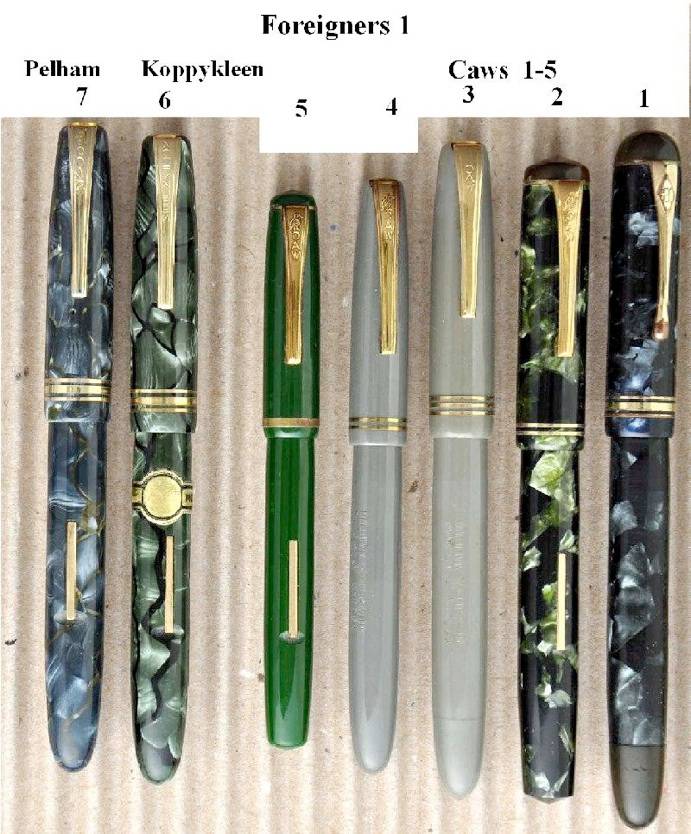
1-5CAW’s:1 =big60;2somewhereinthe50lineage?;3=61;4=54;5=49; 6 Koppykleen; 7 Pelham for Boots
So far, Burnham’s Gamages and Kennards pens haven’t been seen. Pens for CAW’s are on the whole identifiable with specific Burham models, though they are sometimes in different colours. They have CAW’s on the clip and a CAW’s imprint on the barrel and nib. Pens corresponding to 49, 50, 54, 61, and large- dome 59/60 are known. Solid grey seems to have been favoured, in casein for the 54 equivalent and celluloid in the 61 equivalent.
Burnham’s pens for MacNiven and Cameron’s Waverley brand have already been the subject of an article in the WES Journal (vol 77, p.38, 2006). I think it’s fair to say that when I wrote that I hadn’t realised how much could be gained from a detailed survey of Burnham. It’s possible now to equate the Burnham Waverleys more accurately with known Burnham models and to get a better dating. One last very interesting detail evaded me until the last moment – so yet more picture is included – see below group picture. These pens are all lever-fillers.
Waverley 1. The same basic dimensions as the presumed 15F (barrel 87mm), coned ends, 3 unequal cap bands. Clip with gothic B in circle motif, lever with gothic B in single or double circle, nib 6.5mm at shoulders. Imprint on barrel “Waverley” fountain pen, Macniven and Cameron Made in Great Britain. It is a re- badged 15F with some very minor difference in trim, so most probably post-WW2, and the single-circle lever indicates this period too.
Waverley 2 and 3. Large dome on cap with 3 equal narrow bands, barrel with rounded end, length 86 - 87mm, cap thread 7/16 in. O.D. Lever with sunburst motif. Nib 6.5 mm at shoulders. Ball-end clip with W in circle (2) or gothic B in circle (3).
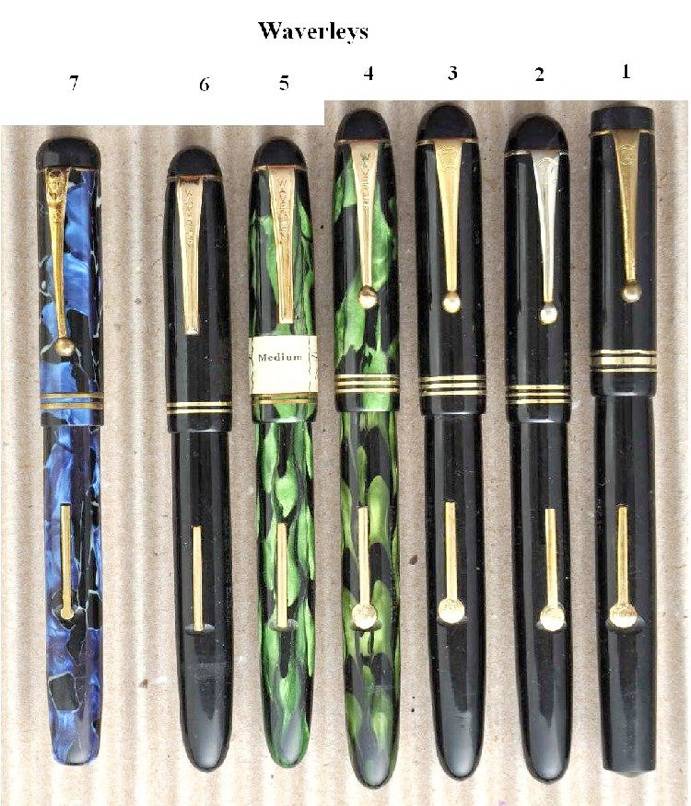
Waverley 4. Small dome on cap with 3 equal narrow bands, barrel with rounded end, length 88mm, cap thread 7/16 in. O.D. Lever with sunburst motif. Nib 6.5 mm at shoulders. Ball-end clip with WAVERLEY lettered vertically.
The barrels of Waverley 2, 3 and 4 are therefore dimensionally the same as the larger 55s and 60s and the nib is large, Burnham 60 size – so they are 60 equivalents. The cap dome of 2 is (externally) like that of the large-dome 59/60, and so is the cap shape. The cap shape and dome of 4 are exactly the same as the small-dome 55. These pens are hybrids in design terms of those particular Burnham pens. Waverley 4 with the small dome and vertically-lettered clip corresponds to what is probably the last form found in the small-dome 55s, so these pens take us into the very early 1950s.
Waverley 5 and 6 have small-dome caps with 2 bands, a little shorter than Waverley 2 , 3. and 4 They have plain straight levers. The barrel is about 82mm. long. So the Waverley 4 corresponds in size to the jewel-clip no. 55, with a different cap. But..... the profile of the caps are the same up to the clip of the Waverley, it is truncated here but the jewel-clip cap continues on, and the overall length of the two is about the same. The Waverley 5 and 6 have the same basic cap as the jewel-clip 55, finished off differently with a small tassie! The clips of the Waverley 5 and 6 are lettered WAVERLEY vertically and they are the same shape and size, with fluted sides, as found in the washer-clip 47 and 51 models. Basically 5 and 6 are 55 equivalents.
Waverley 7 is just included for comparison – it is I think a real Macniven and Cameron product with M and C nib, not Burnham, and the lever is pure Macniven and Cameron also..
So I think it’s fair to say that Burnham’s design department took it all very easy when drawing up the various versions of Waverley. Somehow I don’t suppose anyone in MacNiven and Cameron ever thought about this, or would have bothered if they had. They were taking a good price for their pens anyway. We have one priced-tagged Waverley - pic. 4, priced at 14/9d. This is basically the same pen as the jewel-clipped 55 remember - and that was priced at 12/5 in 1954 which is about the same period as the Waverley.
The last bit of Waverley detail – the large pen shown as Waverley pic. 1 above has coned tassie and barrel ends and a single ring on the lever lollipop. It is probably early post-war, since it’s hard to imagine high-grade pens like this being made for another firm during wartime. On the other hand the pen shown separately here is pre-war.it has flat tassie top and barrel end and the lever lollipop has a double ring. Burnham were making pens for the MacNiven and Cameron imprint Waverley from before the war.

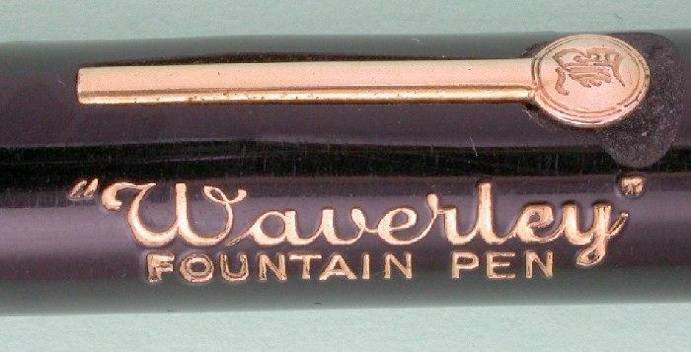
Occasional pens appear with the clip lettered RUGBY, found on a no. 56 and on an older no. 50. These were made for a stationers George Over Ltd. in Rugby.
A Friendly Society, the Manchester Unity of Oddfellow, had versions of the nos.55 and 59 with their own imprint on the body instead of the Burnham imprint. These pens were completely Burnham in other respects. Only comparatively late model pens have been seen, with jewel-fixed clips. In earlier days, probably from before WW2, this society had used Croxley pens made by or for John Dickinson Ltd.
There is a B48 pen with an imprint on the clip which is certainly an acronym - SCCCSC. So far the acronym has not been identified. A tempting track is S...... County Cricket Club Supporters Club but Supporters Clubs for major clubs all seem to have been started later than the date of this pen. The acronym is used for Supreme Court of Canada/Cour Supreme du Canada, but it’s hard to imagine such an august institution having medium-grade fountain pens made by a smallish British firm. It is also used for CSBBSC/SCCCSC, but only the French version fits - Societe Canadienne pour l'etude du Cerveau, du Comportement, et des Sciences Cognitives. Some day the truth about this pen will be revealed?
Article © Alan Charlton 2011


There is a complex of strange pens, with various brand names, and some of these seem to be pens made into "forgeries" and/or "Frankenpens" to masquerade as Conway Stewart or Burnham. Pens in this complex imprinted "Summit" and "New Bond Easiflow" appear genuine and the detail of these pens suggests they are Summit Products.
An oddy with tentacles
A single specimen of a 1950’s appearance Burnham came to Akiva Gordon. It has a Burnham clip and nib, and the section looks Burnham, but it has no imprint.
By itself it might be taken as a very unusual Burnham......but its shape, and general appearance put it with two well-documented pens – Summit S70 and New Bond Easiflow no. 444 – and the probable forgery, the pen known as the Conway Stewart no. 444
Summit S70 and imprint (Jonathan Donahaye)
There’s no information on the nib or section........but probably like the New Bond pens below



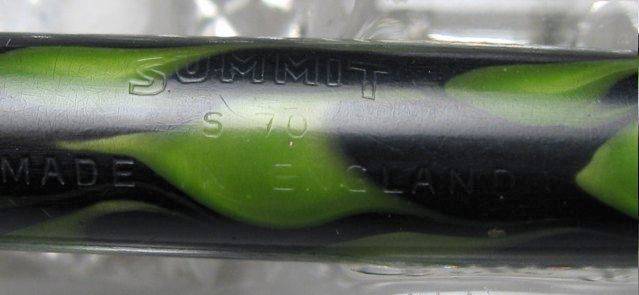



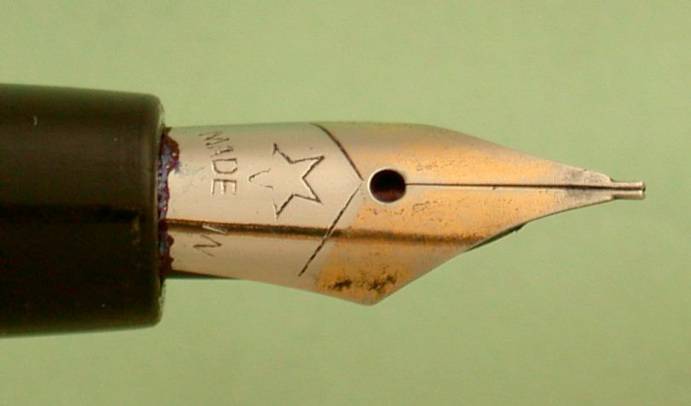
Web pictures of 3 New Bond Easiflow
The New Bond pens are definitely cheap things with a plated nib and moulded section. But like the strange Burnham the putative Conway no. 444 has a gold nib. It also has a Conway lever and clip. But the section is a moulded one like the New Bonds. And the imprint does not actually say Conway Stewart, only No. 444, and it looks as though the upper part of the imprint has been removed. Very suspicious... did someone make a spurious Conway by fitting Conway parts to a New Bond and deleting the name from the imprint?
They did a good job if so, because Steve Hull has accepted this pen as a Conway in his recent book on Conways! And one has to admit the pen looks right in this guise.
Pics below by Jonathan Donahaye.

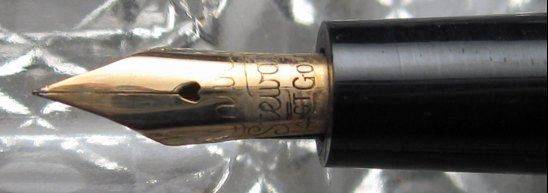

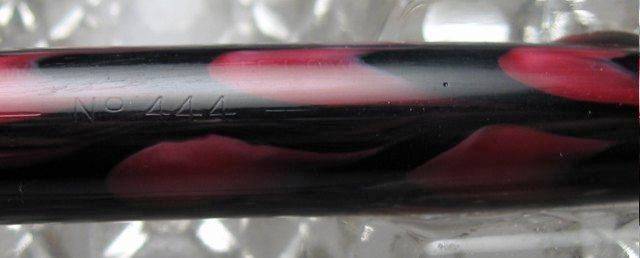
So my conclusion is – if someone can go to that trouble to make up a spurious Conway, it would be equally feasible that someone had created a spurious Burnham.
Article copyright © 2011 Alan Charlton
There are pens we have seen referred to in price lists and/or Steve Hull's historical writings that have not been seen. Although they must have existed, some may never have been identified by number to collectors as the paper number slips have been lost. Others may simply have been too expensive to be sold in quantity.
Out There?
There are several Burnham model numbers that we don’t have pens to match.
From the pre-WW2 and wartime periods Steve Hull has found 182F, 186F, 205F mentioned.
We have a leaflet from a writing set from the BP period. The set or pen wasn’t identified itself. It gives these:
Junior made in Black, Mottle and Coloured
2/6 3/9
5/- 7/6
10/6 12/6 15/- 17/6 5/6 5/6
204F 206F 208F 210F
212F 214F 216F 223F 225F
Black and Mottle handy pocket size
“ “ “
Full Size Reliable Pen Large Nib, R.G. fittings (A triumph of efficiency.
(The pen of Great Performance With two rolled gold mounts
With 9 ct gold mount
An oversize pen with massive nib and the 25 year point Gents artistic mottle colours Rolled gold mounts Ladies “ ” “
It says “All pens fitted with 14ct solid gold nib, and made of the best Vulcanite”. The accuracy of the statement about Vulcanite seems questionable - surely they were using other material than hard rubber almost from the very start.
At least we know what the Junior is. It seems very probable that the Oversize Pen of this leaflet was the “Big Red” equivalent. The 212F could be the model we have pictured elsewhere, with Conway-ish section and two wide bands on the barrel. As for the 208F, with Large Nib and R.G. fittings, it seems unlikely this is an exact equivalent of the 208F model that turns up around the end of WW2.
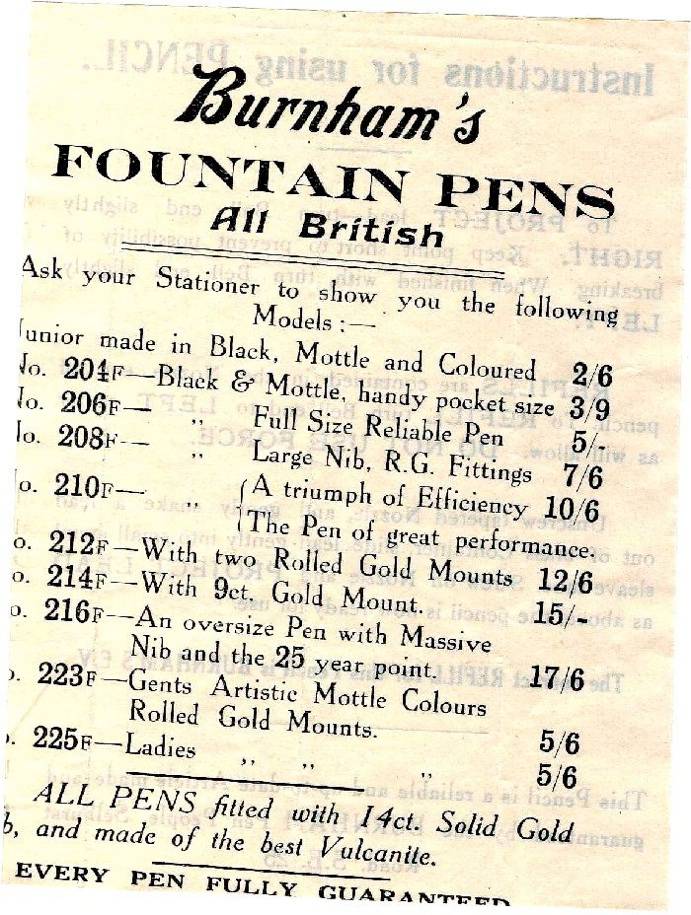
From the wartime we haven’t seen these found (as numbers only) by Steve Hull: 182F, 186F
Then from the early 1950s we haven’t seen or definitely identified:
With tubular gold nibs A50, 8/7; A64
Presumably with conventional gold nibs, several model numbers:
No. 57, 10/6 – but there is a mystery about this model number. In this list No. 57 is very comparable with the No. 56 and might be the ringtop pen shown in the Burnham 56 chapter. The Burnham family have in their possession a much later and more expensive- looking pen imprinted No. 57, which may be a prototype, and I suspect it was not made by Burnham at all. This is discussed elsewhere.
No. 66, 21/5; No. 70, 21/-; No. 75, 25/-; No. 77, 30/-; No. 80, 31/6; No. 90, 35/-
Article © Alan Charlton 2011
Finally, there is a solitary specimen of a Burnham ballpoint; I am sure this was a prototype.
A Ballpoint Pen?
Sometime in the mid-2000s a Burnham ballpoint appeared on ebay. This was probably out of the Conrad Burnham collection of Burnham residua, and probably a prototype. The pen had a standard Parker retractable refill. The pen barrel was machine-turned with grip grooves, and the inner metal parts solid brass with a machined thread. If it was a prototype for possible production it would have been totally uneconomic in this form. Quite a mystery object to finish with
Article © Alan Charlton 2011
